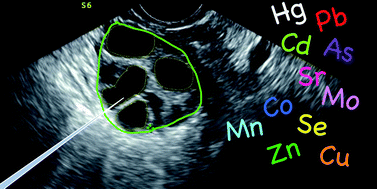Ultra-trace element analysis of human follicular fluid by ICP-MS/MS: pre-analytical challenges, contamination control, and matrix effects
Abstract
Follicular fluid (FF), which is the fluid that envelops the developing oocyte (egg cell) in the ovary, can be analyzed to assess trace element content as well as to determine potential exposure to toxic elements in women seeking in vitro fertilization (IVF) treatment. Such measurements may be useful in establishing associations with potential adverse effects on oocyte viability and subsequent pregnancy outcomes. The principal goal of this study was to leverage the next generation of inorganic mass spectrometry based on ICP-MS/MS to address the numerous analytical challenges of (ultra-)trace element analysis of human FF specimens. Ultra-trace element measurements are defined by the Clinical Laboratory Standards Institute as fluid concentrations below 10 μg L−1 or tissue mass fractions below 1 μg g−1. Stringent pre-analytical procedures were developed to minimize exogenous contamination during FF specimen collection and storage in a prospective study of 56 women seeking IVF treatment. ICP-MS/MS instrumental parameters were carefully optimized, and the method validated for 11 biologically important elements that included 4 at trace levels (Cu, Se, Sr, and Zn) and 7 at ultra-trace levels (As, Cd, Co, Mo, Mn, Hg, and Pb). Method limits of detection (LODs) for ultra-trace elements varied from 5.6 ng L−1 for Cd to 0.11 μg L−1 for Mo. A total of 197 human FF specimens were analyzed using the proposed ICP-MS/MS method with 84% of specimens detectable for Pb and 100% detectable for Co, Cu, Mn, Mo, Sr, and Zn. The method based on ICP-MS/MS was compared to a previous method developed for FF using SF-ICP-MS.

- This article is part of the themed collection: Community Leaders: Alfredo Sanz-Medel


 Please wait while we load your content...
Please wait while we load your content...